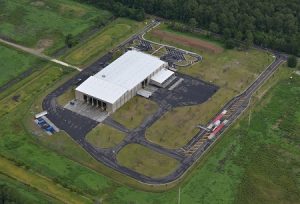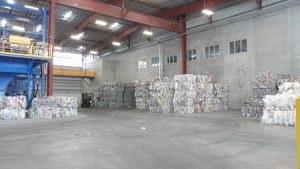What factors are included in designing a MRF? What needs to be included in order to ensure a successfully operated facility? How are these factors identified?
Jeff Eriks
When designing a material recourse facility (MRF) or recycling center, it is always important that certain factors are considered as they will affect the long-term operations of the facility. A few of these factors including products/commodities, system and building throughput, outbound material, maintenance, safety and site considerations are discussed in this article to help during the planning process. Many other factors that are not included here need to be considered and should be discussed prior to designing the facility. In this article, we discuss key factors that we feel are extremely important in the process of designing a MRF or recycling center.
Products and/or Commodities
This first section focuses on the actual product and/or commodity being processed at a MRF. This is the center of the facility, so it is important it is designed around this factor. The make-up of the material or characteristics will lead to the equipment design as it needs to be efficient in processing the material. It is necessary to be able to remove the right thing at the right time and have the bunker sized appropriately to handle the material. The “evolving ton” and how your market will change in the coming years needs to be understood. This will affect how the equipment designer sets the equipment up to morph in the future and handle the growing and changing products received.
Along with the product itself, it is necessary to understand how it comes into the building. What is the product flow? Are there peaks and valleys? Does it come in co-mingled or do loads come in clean and what kind of trucks bring these into the facility? These factors affect how a facility is designed to handle these different ebbs and flows as well as the different types of trucks and how they tip. It is also important that you make sure trucks can get into and out of the facility as expeditiously as possible. This will be important to keep your costs low (if you haul your own recyclables) or to keep third-party haulers happy so they don’t spend time waiting at a facility. If their trucks can keep moving through the facility, they will likely keep coming back. Lastly, how does the product leave the facility? Is it sent out loose or in bales or a combination of both? Having the ability to understand who is taking the various products will allow you to understand how to accommodate the outbound product and vehicles.
System and Building Throughput
Next we will discuss the throughput of the system and building. Once the process of materials is understood, we move on to the system itself. The equipment company contracted will work to help analyze material and develop the parameters of the system and specifications of what it will need to accomplish in a given day to process the material and keep floors empty at the end of the day while also keeping residuals low.
Understanding how much the system will process an hour is needed in order to make sure required needs are met. If 300 tons are brought in and a 25 ton per hour system is installed, you will need to be open a minimum of 12 hours per day to process all the material, plan for downtime and prepare for the next day. Understanding how materials will be sorted is also necessary during this step. Will you have optics, manual sort, screens, glass breakers, drum feeders, etc.? There are many options for handling throughput that affect the building layout, equipment access, power requirements and many other factors, so it is important to work with a design/build construction company working simultaneously with the equipment supplier(s). The flexibility of the system should also be understand to handle any operational issues and maintenance requirements. The ability to have a lot of downtime can be challenging because systems are typically designed to handle your current daily throughput needs. Redundancy should be built into the system so that material can move around as needed to avoid areas that are out of commission. One large area to focus on is balers. If the baler is down or being rebuilt, understanding how to deal with sorted material is necessary. Will you stockpile? Send it out loose? Knowing this plan will allow to properly plan the building and storage capacity.
Outbound Material
Outbound material is the next factor to think about during the process of designing a MRF facility. The amount, different types and how the material is broken down in the system will affect how much bunker storage is needed and how to send it off the property. The “how” of dealing with residuals is important because it can be sent away loose, put in a semi or compacted to ship it to a landfill cost effectively. Not if, but when the material changes over time it will be important to understand how that affects existing outbound means and methods. How much bale storage and loading docks are necessary to have on the property will affect how to deal with shipping issues in the future, if there are problems getting tractor trailers, shipping overseas or many other issues.
Maintenance
Another point to consider is maintenance. How will maintenance need to occur in order to properly design the facility for equipment access to complete routine maintenance? The daily, weekly, monthly, quarterly and annual maintenance for the facility needs to be planned in order to keep the system up and running. A proper storage area for the parts and required equipment needed to maintain it should be included in the planning of the facility. Determining the facility needs for these factors will allow an effective plan to be developed for maintenance staff, the size of the parts storage area and maintenance shop and the amount of time required to shut down the system to perform the maintenance. All of these factors should all be included when planning the design to tie them all together.
Safety
Employee safety is always important. This pertains to the drivers, plant workers, equipment operators and anyone else that may enter the site or facility. The safety features of the facility should be very detailed, looking at fall risks, railings, painted walk ways, proper signage and other factors. Safety needs to be considered during design and construction as well us just before operations are to begin. In terms of equipment, look at E-stop controls, fences to stop people from walking under equipment, fall protection, employee PPE, proper lighting, hydration and keeping workers from walking through areas where yellow iron (loaders, excavators, etc.) and forklifts might be operating. The last piece is proper training on all aspects of the equipment and notifying employees when they might be in danger. This is an ongoing task that needs to be continually performed and updated based on new procedures and changes in operations.
Site Considerations
Lastly, let’s discuss the site considerations. Access into and out of a recycling facility can be a very tricky and highly important factor of the long-term success of your facility. Ensure that there is access all around the building to different areas of the facility for bin removal, access collection areas, tipping areas, swapping boxes as well as general maintenance and fire access. The site should be properly marked with signage dictating who is allowed to access different areas, speed limits, direction arrows and other site specifics requirements. Traffic should be properly directed to the tipping area and precautions should be taken to ensure that there are no incidents on the site between inbound vehicles. Make sure that there is enough queuing for the scales in both directions so traffic isn’t blocked on the entrance road or vehicles trying to get to your facility. Moving trucks around the site needs to be carefully thought out as well so a safe traffic pattern can be maintained. In our opinion, crossing traffic patterns should be avoided when possible to prevent any potential conflicts. Setting up scales to properly handle throughput is also a consideration. The design of the facility should include enough scales so trucks can get on and off them as quickly as possible. The computer system used on the scales is also a factor in making sure tickets can be processed quickly and efficiently. Proper research on this system and proper training of employees to use it are key. Another key issue for a site is proper lighting for those times of operation when there isn’t enough daylight to properly see the site. Key areas need more light than others and it is important that this is carefully considered during the design process. The final item that needs to be considered is separating employee vehicle traffic from commercial traffic. Separating traffic patterns can help to reduce incidents when you open. This also applies to site visitors.
Conclusion
The items discussed in the process are not all inclusive of the items needed to be considered when designing a MRF; there are many other factors to consider from the very beginning of need identification and facility design. As the process of identifying needs and evaluating materials is conducted, it is important that the right team is brought to the table. The ability of a chosen team to analyze material and develop the equipment and facility to process it will ultimately determine how successful you are in the long term.
Jeff Eriks is the Chief Business Development Officer for Cambridge Companies (Griffith, IN), a design-build firm hired to work with the City of Cape Girardeau (Missouri) on a new Transfer Station. Cambridge has worked in the waste industry for more than 20 years. During this time, more than 100 solid waste design-build projects have been completed including new build, repairs, upgrades and/or modifications at transfer stations, recycling centers/MRFs, hauling companies, landfill facilities, office buildings and more.Cambridge continually monitors the industry to determine any new needs, changes or improvements that will benefit their clients and improve their design-build solutions. Jeff can be reached at (219) 313-0813, via e-mail at [email protected] or visit www.CambridgeCoInc.com.




